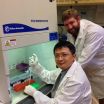(Press-News.org) VANCOUVER, BRITISH COLUMBIA – Conventional wisdom holds that when the risk of catching a disease is high, people are more likely to get vaccinated to protect themselves.
This may not be the case, however, according to a study to be presented Monday, May 5, at the Pediatric Academic Societies (PAS) annual meeting in Vancouver, British Columbia, Canada.
Researchers, led by Elizabeth R. Wolf, MD, FAAP, compared rates of infant vaccination with the diphtheria, tetanus and pertussis vaccine (DTaP) before and during an epidemic of pertussis (whooping cough) in Washington state. Surprisingly, they found no difference in vaccination rates.
"We have always assumed that when the risk of catching a disease is high, people will accept a vaccine that is effective in preventing that disease. Our results may challenge this assumption," said Dr. Wolf, the Ruth L. Kirschstein National Research Service Award Fellow in General Academic Pediatrics at University of Washington, Seattle Children's Research Institute.
Washington state experienced a pertussis epidemic from Oct. 1, 2011, through Dec. 31, 2012, and infants were hit the hardest. The highly contagious bacterial disease causes uncontrollable, violent coughing that can make it hard to breathe. Pertussis also is known as whooping cough because a "whooping" sound often is heard when the patient tries to take a breath. Pertussis can lead to pneumonia, seizures (jerking and staring spells), brain damage and death.
Dr. Wolf and her colleagues compared the proportion of 3- to 8-month-olds who had received the recommended number of doses of pertussis-containing vaccine before the epidemic and during the epidemic. Infants who received at least one dose by 3 months of age, at least two doses by 5 months and at least three doses by 7 months are considered up to date by the Advisory Committee on Immunization Practices of the Centers for Disease Control and Prevention.
"We hypothesized that a whooping cough epidemic would result in more parents getting their children immunized against whooping cough," Dr. Wolf said. "But compared to a time before the 2011-2012 whooping cough epidemic in Washington state, there was no significant increase in receipt of whooping cough vaccines for infants during the epidemic."
Results did show considerable variability in vaccination rates among different counties.
"Vaccination rates in the U.S. are still below public health goals," Dr. Wolf noted. "We don't fully understand what improves vaccine acceptance. This study found no significant increase in vaccination coverage statewide during the 2011-2012 pertussis epidemic. This finding may challenge the assumption that vaccine acceptance uniformly increases when risk of disease is high."
INFORMATION:
Dr. Wolf will present "The Effect of the 2011-2012 Pertussis Epidemic on Infant DTaP Vaccination in Washington State" from 12:00-12:15 p.m. Monday, May 5. To view the study abstract, go to http://www.abstracts2view.com/pas/view.php?nu=PAS14L1_3380.7.
The study was funded by a grant from the National Institutes of Health (T32HP10002).
The Pediatric Academic Societies (PAS) are four individual pediatric organizations that co-sponsor the PAS Annual Meeting – the American Pediatric Society, the Society for Pediatric Research, the Academic Pediatric Association, and the American Academy of Pediatrics. Members of these organizations are pediatricians and other health care providers who are practicing in the research, academic and clinical arenas. The four sponsoring organizations are leaders in the advancement of pediatric research and child advocacy within pediatrics, and all share a common mission of fostering the health and well-being of children worldwide. For more information, visit http://www.pas-meeting.org. Follow news of the PAS meeting on Twitter at http://twitter.com/PedAcadSoc.
Disease outbreak may not spur parents to have children vaccinated
Rates of infant immunization with pertussis-containing vaccine do not increase with epidemic in Washington state
2014-05-05
ELSE PRESS RELEASES FROM THIS DATE:
Few children receive dental care before recommended age of 1 year
2014-05-05
TORONTO, May 5, 2014—Less than one per cent of healthy urban children surveyed in Toronto had received dental care by the recommended age of 12 months and less than two per cent had seen a dentist by the age of 24 months.
Children most susceptible to cavities were least likely to receive early dental care, according to the study by Dr. Jonathon Maguire, a pediatrician and researcher at St. Michael's Hospital.
Of the 2,505 children around 4 years of age who were surveyed from 2011-13, 39 per cent had never been to a dentist. The children were part of TARGet Kids! (The ...
Food security increased by new scientific model in agricultural production
2014-05-05
Farmers are used to optimizing crop production on their own lands. They do soil tests to choose the right amount of fertilizers to apply, and they sometimes plant row crops on some fields while keeping others in pasture.
But is it possible to optimize production across a much bigger area—say, the whole East Coast of the United States? That's the question a team of USDA-ARS scientists in Beltsville, MD, has begun to tackle by developing a sophisticated new modeling tool.
Known as the Geospatial Agricultural Management and Crop Assessment Framework (GAMCAF), the tool ...
Study exposes risk of nutritional deficiencies in obese teens
2014-05-05
A new study exposes the risk of nutritional deficiencies in severely obese teens – both those who had weight loss surgery and those who did not.
At least five years after undergoing gastric bypass surgery, teens and young adults maintained significant weight loss but were at risk of nutritional deficiencies, particularly low iron, mild anemia and low vitamin D. The study also found low iron and low vitamin D in severely obese teens who did not undergo weight loss surgery. Those who didn't have surgery also had low levels of protein in their blood.
The Cincinnati Children's ...
Lean patients with fatty liver disease have higher mortality rate
2014-05-04
Chicago, IL (May 4, 2014) — Despite being of a healthier weight, lean patients with nonalcoholic fatty liver disease (NAFLD) have a higher overall mortality rate than patients with NAFLD who are overweight or obese, according to new research presented today at Digestive Disease Week® (DDW). In addition to finding higher mortality rates, an international team of researchers found that lean patients [a body mass index (BMI) less than 25] with NAFLD were more likely to be male, non-Caucasian and to have lower rates of chronic conditions, such as diabetes and hypertension. ...
Arizona Sate University scientists take steps to unlock the secrets to the fountain of youth
2014-05-04
ASU scientists, together with collaborators from the Chinese Academy of Sciences in Shanghai, have published today, in Nature Structural and Molecular Biology, a first of its kind atomic level look at the enzyme telomerase that may unlock the secrets to the fountain of youth.
Telomeres and the enzyme telomerase have been in the medical news a lot recently due to their connection with aging and cancer. Telomeres are found at the ends of our chromosomes and are stretches of DNA which protect our genetic data, make it possible for cells to divide, and hold some secrets as ...
Study unveils new approach to treating brittle bone disease
2014-05-04
HOUSTON – (May 4, 2014) – Researchers at Baylor College of Medicine have identified a new approach to treating brittle bone disease, a congenital disorder that results in fragile bones that break easily.
The study, published in the current issue of the journal Nature Medicine, showed that excessive activity of an important signaling protein in the matrix of the bone called transforming growth factor beta is associated with the cause of the disease.
"There are many genetic causes of brittle bone disease in children and adults," said Dr. Brendan Lee, professor of molecular ...
New method for measuring the temperature of nanoscale objects discovered
2014-05-04
Temperature measurements in our daily life are typically performed by bringing a thermometer in contact with the object to be measured. However, measuring the temperature of nanoscale objects is a much more tricky task due to their size - up to a thousand times smaller than the width of a human hair.
Pioneering research, published in Nature Nanotechnology, has now developed a method to accurately measure the surface temperature of nanoscale objects when they have a different temperature than their environment. A team led by Dr Janet Anders at the University of Exeter ...
New insight may help predict volcanic eruption behavior
2014-05-04
VIDEO:
Using friction experiments University of Liverpool scientists have shown that frictional melting plays a role in determining how a volcano will erupt.
Click here for more information.
A new discovery in the study of how lava dome volcanoes erupt may help in the development of methods to predict how a volcanic eruption will behave, say scientists at the University of Liverpool.
Volcanologists at the University have discovered that a process called frictional melting plays ...
Functioning of aged brains and muscles in mice made younger
2014-05-04
Cambridge, MA, May 4 - Harvard Stem Cell Institute (HSCI) researchers have shown that a protein they previously demonstrated can make the failing hearts in aging mice appear more like those of young health mice, similarly improves brain and skeletal muscle function in aging mice.
In two separate papers given early online release today by the journal Science – which is publishing the papers this coming Friday, Professors Amy Wagers and Lee Rubin, of Harvard's Department of Stem Cell and Regenerative Biology (HSCRB), report that injections of a protein known as GDF11, which ...
New study sheds light on global warming trends
2014-05-04
TALLAHASSEE, Fla. — New research by a team of Florida State University scientists shows the first detailed look at global land surface warming trends over the last 100 years, illustrating precisely when and where different areas of the world started to warm up or cool down.
The research indicates that the world is indeed getting warmer, but historical records show that it hasn't happened everywhere at the same rate.
And that new information even took scientists by surprise.
"Global warming was not as understood as we thought," said Zhaohua Wu, an assistant professor ...
LAST 30 PRESS RELEASES:
Numbers in our sights affect how we perceive space
SIMJ announces global collaborative book project in commemoration of its 75th anniversary
Air pollution exposure and birth weight
Obstructive sleep apnea risk and mental health conditions among older adults
How talking slows eye movements behind the wheel
The Ceramic Society of Japan’s Oxoate Ceramics Research Association launches new international book project
Heart-brain connection: international study reveals the role of the vagus nerve in keeping the heart young
Researchers identify Rb1 as a predictive biomarker for a new therapeutic strategy in some breast cancers
Survey reveals ethical gaps slowing AI adoption in pediatric surgery
Stimulant ADHD medications work differently than thought
AI overestimates how smart people are, according to HSE economists
HSE researchers create genome-wide map of quadruplexes
Scientists boost cell "powerhouses" to burn more calories
Automatic label checking: The missing step in making reliable medical AI
Low daily alcohol intake linked to 50% heightened mouth cancer risk in India
American Meteorological Society announces Rick Spinrad as 2026 President-Elect
Biomass-based carbon capture spotlighted in newly released global climate webinar recording
Illuminating invisible nano pollutants: advanced bioimaging tracks the full journey of emerging nanoscale contaminants in living systems
How does age affect recovery from spinal cord injury?
Novel AI tool offers prognosis for patients with head and neck cancer
Fathers’ microplastic exposure tied to their children’s metabolic problems
Research validates laboratory model for studying high-grade serous ovarian cancer
SIR 2026 delivers transformative breakthroughs in minimally invasive medicine to improve patient care
Stem Cell Reports most downloaded papers of 2025 highlight the breadth and impact of stem cell research
Oxford-led study estimates NHS spends around 3% of its primary and secondary care budget on the health impacts of heat and cold in England
A researcher’s long quest leads to a smart composite breakthrough
Urban wild bees act as “microbial sensors” of city health.
New study finds where you live affects recovery after a hip fracture
Forecasting the impact of fully automated vehicle adoption on US road traffic injuries
Alcohol-related hospitalizations from 2016 to 2022
[Press-News.org] Disease outbreak may not spur parents to have children vaccinatedRates of infant immunization with pertussis-containing vaccine do not increase with epidemic in Washington state




